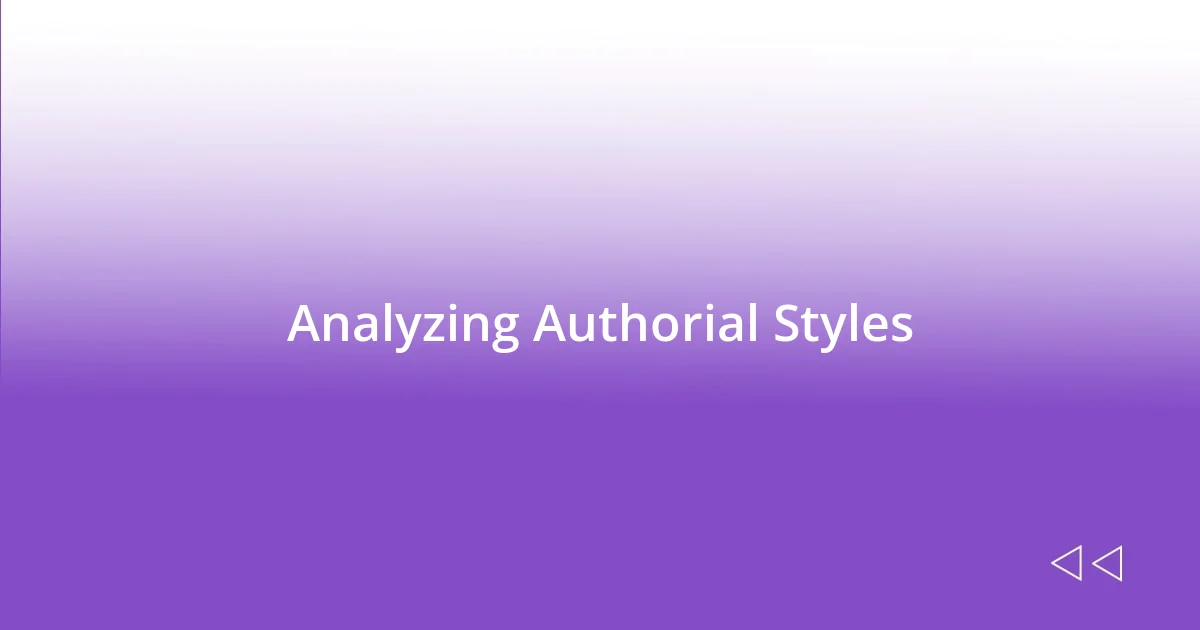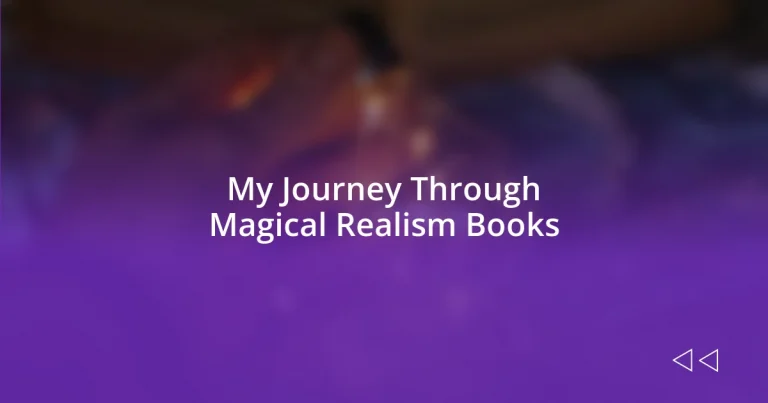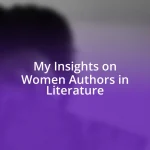Key takeaways:
- Magical realism fuses the ordinary with the extraordinary, revealing deeper emotional truths and reflections on reality through metaphors and symbolism.
- Key characteristics include blending of reality with fantastical elements, emotional depth, cultural context, subtle presentation of magic, and layered symbolism.
- Engaging with magical realism invites readers to explore themes personally and revisit texts for deeper insights, emphasizing the interconnectedness of genres and the richness of narrative experiences.

Understanding Magical Realism
Magical realism blends the ordinary with the extraordinary, allowing fantastical elements to coexist with everyday life. I remember reading “One Hundred Years of Solitude” by Gabriel García Márquez and being both enchanted and perplexed by the world these characters inhabited. Have you ever felt that tingle of recognition when something miraculous happened in a familiar setting?
What fascinates me about magical realism is its ability to evoke deep emotions by presenting truths through metaphors. In “The House of the Spirits” by Isabel Allende, the mystical occurrences shape the narrative but also resonate with the characters’ struggles and triumphs. It’s like peeling back the layers of reality to uncover hidden meanings—doesn’t that make you ponder the magic in your own life?
In many ways, magical realism reflects our inner worlds, intertwining reality with dreams, memories, and desires. When I found a passage where a character’s thoughts suddenly manifested as visible emotions, it felt cathartic—almost as if the author was giving voice to the unspoken feelings we all harbor. How often do we wish we could express our innermost thoughts so freely? This genre creates a safe space where those feelings can come to life.

Defining Key Characteristics
Exploring magical realism, I find several defining characteristics that truly encapsulate this genre. One key element is its seamless blend of the ordinary and the extraordinary. I remember reading about a character who effortlessly conversed with ghosts while commuting through the bustle of a city. It struck me how normal an uncanny encounter felt, almost like a vivid dream that lingers in your mind long after waking.
Key characteristics of magical realism include:
– Blurring of boundaries: Reality intertwines with fantastical elements, often without explanation.
– Emotional depth: The magical components often reflect inner truths or societal themes.
– Cultural context: These stories frequently draw from local folklore or tradition, enriching the narrative landscape.
– Subtle presentation: Magical events are reported in a straightforward manner, creating a contrast that highlights their significance.
– Symbolism: Objects or occurrences often serve dual roles, representing both tangible reality and deeper meanings.
I find it fascinating how the characters navigate this unique reality. For instance, in a novel, a simple canary’s song could evoke a wave of nostalgia and love—a reminder of a lost relationship. Moments like these remind me of how an ordinary sensation can transform into something profoundly magical. It’s like discovering a hidden treasure in the mundane, don’t you think?

Exploring Must-Read Titles
When I think about must-read titles in magical realism, a few gems come to mind that truly shaped my experience. “The Night Circus” by Erin Morgenstern is one such title; the enchanting story weaves a narrative where a magical competition unfolds amidst a dreamlike circus that appears only at night. I recall being utterly mesmerized by the imagery—the way the tents seemed to breathe life and mystery, transforming my perception of what a circus could be. It invites readers to explore the balance of love, rivalry, and the unseen forces that shape our destinies.
Another noteworthy title is “Kafka on the Shore” by Haruki Murakami. Early in my reading journey, I was drawn to the way Murakami seamlessly blends surreal elements with the journey of self-discovery. I still can’t forget the moments when cats conversed with people, or when characters traversed a metaphysical landscape—a reminder that the boundaries of reality are often more flexible than we perceive. The emotional potency of Murakami’s storytelling left a lasting impression, making me reflect on my own dreams and the meaning behind them.
Finally, there’s “Like Water for Chocolate” by Laura Esquivel, where the act of cooking turns into a magical experience imbued with emotion. I remember the sensation of tasting a dish while reading the book, feeling the characters’ joys and sorrows through their culinary creations. This book eloquently illustrates how food can awaken memories and emotions, reminding us that even the simplest acts can possess extraordinary significance.
| Title | Author | Key Element |
|---|---|---|
| The Night Circus | Erin Morgenstern | Magical competition amidst a dreamlike setting |
| Kafka on the Shore | Haruki Murakami | Surreal exploration of self-discovery |
| Like Water for Chocolate | Laura Esquivel | Food as a bridge to emotions and memories |

Analyzing Authorial Styles
When analyzing authorial styles in magical realism, I often turn my attention to how writers uniquely integrate fantastical elements into their narratives. Each author brings a distinct voice that shapes the reader’s experience. For instance, I find it intriguing how Gabriel García Márquez utilizes lush, sensory descriptions to create a dreamlike atmosphere; it’s as if you can almost feel the warmth of Macondo’s sun on your skin while reading. His style invites readers to fully immerse themselves in a world where reality is perpetually tinged with magic.
The emotional undertones in a writer’s style can be equally captivating. Isabel Allende, for example, often infuses her stories with a profound sense of nostalgia and familial bonds. I recall feeling a deep connection with her characters as they navigated love, loss, and historical events through a magical lens. When an author can evoke such empathy, it truly enhances the reading experience. How do you feel when a character’s journey resonates with your own experiences? Personally, I cherish those moments, as they remind me of the universal truths that bind us together.
Examining the subtlety of magical events is another vital aspect of authorial style that fascinates me. In works by authors like Toni Morrison, the magical elements appear almost casually, woven into the fabric of everyday life. I remember being struck by this technique; the appearance of mystical elements felt natural rather than intrusive. It made me question my own perception of reality and the hidden magic in my daily encounters. Have you ever had a moment where something ordinary suddenly felt extraordinary? I believe that’s the beauty of magical realism—it encourages us to uncover the magic that lies beneath our surface reality.

Personal Insights and Reflections
Reflecting on my journey through magical realism, I can’t help but feel that these narratives have reshaped my understanding of reality. One moment that stands out occurred while reading “The House of the Spirits” by Isabel Allende; the way souls subtly interacted with the living left me contemplating my own experiences with loss and memory. It was almost as if the lines between life and afterlife blurred, prompting me to ponder the legacies we leave behind.
There have been times when a book moved me so deeply that I found myself questioning my own beliefs. For example, after finishing “One Hundred Years of Solitude” by Gabriel García Márquez, I felt a compelling urge to look around my world more intently, as if hidden stories and magic lay just out of sight. Can you recall a book that prompted a shift in your perspective? In that moment, I realized how intertwined our realities can be with the echoes of our pasts—how a narrative can turn the mundane into something rich and colorful.
Sometimes, it’s not just the grand magical elements but the subtler nuances that resonate with me. I remember a passage about a simple rain shower in “The Night Circus” that transformed into a symphony of lights and emotions. It struck me that everyday moments, much like magical realism, often hold extraordinary depths. Have you encountered a fleeting moment that made you pause and appreciate the beauty around you? This reflection reminds me that within our own lives lies a tapestry of hidden magic, waiting to be unraveled.

Tips for New Readers
When diving into magical realism for the first time, my advice would be to approach it with an open mind. I remember feeling hesitant about the blend of the ordinary and the extraordinary. Rather than trying to rationalize every strange occurrence, I found it helpful to simply absorb each moment and let the story wash over me. Have you ever had that experience where you just surrendered to a book and felt completely transported? It’s truly magical.
Also, don’t be afraid to revisit passages that capture your imagination. In my case, there were lines in “Midnight’s Children” by Salman Rushdie that I read multiple times. Each re-read offered fresh interpretations and deeper insights. Isn’t it fascinating how a single sentence can unfold differently based on your own perspective in the moment? These narratives often invite layers of meaning that can enrich your understanding.
Lastly, engage with the themes that resonate with you personally. I often underline phrases or ideas that reflect my own life experiences, like the importance of family or the intersection of dreams and reality. Sometimes I find myself journaling about these themes afterward. It really deepens my connection to the material. Have you thought about how a book might mirror your own life? That reflection can turn reading into a profoundly personal journey.

Connecting with Other Genres
There’s something intriguingly connective about magical realism and how it intertwines with other genres. When I read “Like Water for Chocolate” by Laura Esquivel, I appreciated the way romance infused with cultural traditions danced with surreal elements. The kitchen became a character of its own, illustrating how food and love can create magic. Have you ever noticed how a specific genre can complement and enhance another, creating a more immersive experience?
The intriguing blend of magical realism with historical fiction has also captivated me. For instance, in “The Brief Wondrous Life of Oscar Wao” by Junot Díaz, the narrative moves back and forth in time, with magical elements layered over the harsh realities of Dominican history. I found this combination striking, as it highlighted the echoes of the past while weaving in rich, fantastical storytelling. Isn’t it fascinating how different genres can shine a light on the same truth, each offering a unique lens through which to view existence?
I’ve often reflected on how science fiction can embrace magical realism, too. “The Wind-Up Bird Chronicle” by Haruki Murakami has layers of both, blurring the lines between the possible and the impossible. I remember the sense of wonder it sparked in me—how dreams and reality intertwined, much like the complexities of human experience. Do you see how these overlaps enrich our literary journeys by enabling us to explore themes from multiple angles?














